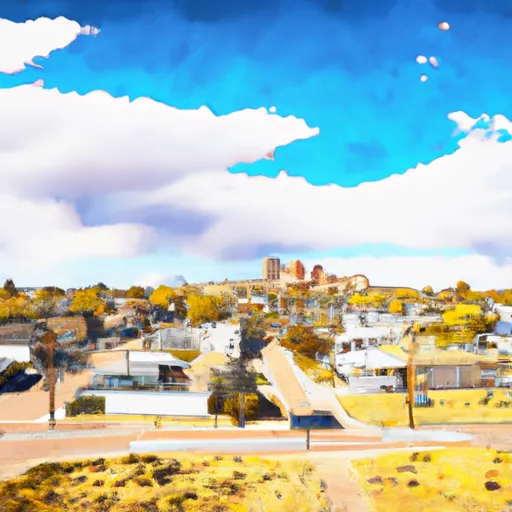-
 Snoflo Premium
Snoflo Premium
Get unlimited access to all our content
With no Ad interruptions! - Start Your Free Trial Login with existing account
Kit-Carson
Eden Index
Climate
8.8
•
Recreation
•
Community
1.5
•
Safeguard
3.9/10

Kit Carson is a small town located in eastern Colorado, known for its unique climate, hydrology constituents, and outdoor recreation opportunities. The region experiences a semi-arid climate, characterized by hot summers and cold winters. Summers are generally warm with temperatures reaching the mid-80s Fahrenheit, while winters can be harsh with temperatures dropping below freezing, averaging in the 30s.
Hydrologically, Kit Carson benefits from the proximity to the nearby Republican River and several reservoirs, ensuring a reliable water supply for the community. This allows for various recreational activities such as fishing, boating, and swimming. The river and reservoirs are home to several fish species, including trout and bass, providing ample opportunities for anglers.
Outdoor enthusiasts will find numerous recreational opportunities in Kit Carson. The surrounding landscape offers vast areas for hiking, camping, and wildlife watching. Additionally, the area is known for its hunting opportunities, with a variety of game species such as deer, elk, and pheasants.
In summary, Kit Carson's climate features hot summers and cold winters, while its hydrology constituents provide ample water resources for outdoor activities. Visitors can enjoy fishing, boating, hunting, hiking, and camping, making it an ideal destination for nature lovers and adventure seekers.
What is the Eden Index?
The Snoflo Eden Index serves as a comprehensive rating system for regions, evaluating their desirability through a holistic assessment of climate health, outdoor recreation opportunities, and natural disaster risk, acknowledging the profound impact of these factors on livability and well-being.
Climate Health Indicator (CHI): 8.8
Kit-Carson receives approximately
384mm of rain per year,
with humidity levels near 50%
and air temperatures averaging around
11°C.
Kit-Carson has a plant hardyness factor of
5, meaning
plants and agriculture in this region thrive during a short period during spring and early summer. Most
plants will die off during the colder winter months.
By considering the ideal temperature range, reliable water supplies, clean air, and stable seasonal rain or snowpacks, the Climate Health Indicator (CHI) underscores the significance of a healthy climate as the foundation for quality living.
A healthy climate is paramount for ensuring a high quality of life and livability in a region, fostering both physical well-being and environmental harmony. This can be characterized by ideal temperatures, reliable access to water supplies, clean air, and consistent seasonal rain or snowpacks.
Weather Forecast
Streamflow Conditions
Upper Arkansas
Area Rivers
Upper Arkansas
Snowpack Depths
Upper Arkansas
Reservoir Storage Capacity
Upper Arkansas
Groundwater Levels
Recreational Opportunity Index (ROI):
The Recreational Opportunity Index (ROI) recognizes the value of outdoor recreational options, such as parks, hiking trails, camping sites, and fishing spots, while acknowledging that climate plays a pivotal role in ensuring the comfort and consistency of these experiences.
Access to outdoor recreational opportunities, encompassing activities such as parks, hiking, camping, and fishing, is crucial for overall well-being, and the climate plays a pivotal role in enabling and enhancing these experiences, ensuring that individuals can engage in nature-based activities comfortably and consistently.
Camping Areas
| Campground | Campsites | Reservations | Toilets | Showers | Elevation |
|---|---|---|---|---|---|
| Point - John Martin State Park | 65 | 3,884 ft | |||
| Lake Hasty - John Martin State Park | 213 | 3,756 ft |
Catastrophe Safeguard Index (CSI):
The Catastrophe Safeguard Index (CSI) recognizes that natural disaster risk, encompassing floods, fires, hurricanes, and tornadoes, can drastically affect safety and the overall appeal of an area.
The level of natural disaster risk in a region significantly affects safety and the overall livability, with climate change amplifying these risks by potentially increasing the frequency and intensity of events like floods, fires, hurricanes, and tornadoes, thereby posing substantial challenges to community resilience and well-being.
Community Resilience Indicator (CRI): 1.5
The Community Resilience Indicator (CRI) recognizes that education, healthcare, and socioeconomics are crucial to the well-being of a region. The CRI acknowledges the profound impact of these elements on residents' overall quality of life. By evaluating educational resources, healthcare accessibility, and economic inclusivity, the index captures the essential aspects that contribute to a thriving community, fostering resident satisfaction, equity, and social cohesion.

